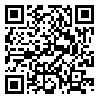Articles accepted at the time of publication
Back to the articles list |
Back to browse issues page
1- Master's student in public linguistics
2- Assistant Professor of English Department of Razi University ,mehdifattahi3@gmail.com
3- Associate Professor of English at Razi University
2- Assistant Professor of English Department of Razi University ,
3- Associate Professor of English at Razi University
Abstract: (3243 Views)
Ayat al-ahkam of prayer are verses in which divine commands about prayer are in the form of prescriptive discourse; But the point that is raised about such verses is that despite the rule of prescriptive discourse on them, in many of these verses, the actor is one of the components of inductive discourse (encouragement, threat, etc.) has also used; For this reason, in this research, it is the question of what function the inductive discourses have in these verses, and despite them, what kind of discourse structure does this category of commandment verses have? In this research, which was carried out with the analytical and applied method and based on the semiotic-semantics approach of Garmes, an attempt has been made to examine the 17 verses of the Qur'an, which are known as the commandments of prayer, from the point of view of prescriptive and inductive discourse, in order to determine how their discourse structure is. And the function of inductive discourses should also be clarified in these verses; The findings of this research show that the inductive discourses used in addition to the prescriptive discourse are anti-discourses that have provided semantic support to the performance of the prescriptive action by the actors in two ways, and their presence has created a unified system of prescription and induction in these verses. Is.
Keywords: The Qur'an, the verses of prayer, prescriptive discourse, inductive discourse, anti-discourse.
Article Type: مقالات علمی پژوهشی |
Subject:
Semiotics
Send email to the article author
| Rights and permissions | |
 |
This work is licensed under a Creative Commons Attribution-NonCommercial 4.0 International License. |







